
Selective Timeline
1942 Robert Heinlein – Waldo
1943 – Deaton Puppet Animating Harness Patent
1948 GE Master-Slave Manipulator – John Payne
1948 Ray Goertz Master-Slave Manipulator
1954 Ray Goertz Electric Servo-Manipulator
1956 GE Yes Man – Exoskeleton Manipulator
1963 Science & Mechanics – "Waldo" as master-slave manipulators
1963 Rogers et al / Disney – Patent for Animating Apparatus
1990 WaldoTM The Character Shop
1942 – Robert Heinlein – Waldo
Waldo (1942) is a short story by Robert A. Heinlein originally published in Astounding Magazine in August 1942 under the pseudonym Anson MacDonald (see cover image by Hubert Rogers above). It is available in the book Waldo & Magic, Inc., as well as other collections.
{Note: In Heinlein's book Waldo, it has a copyright date of 1940 as well as 1942. )
From wikipedia – The essence of the story is the journey of a mechanical genius from his self-imposed exile from the rest of humanity to a more normal life, conquering the disease myasthenia gravis as well as his own contempt for humans in general. The key to this is that magic is loose in the world, but in a logical and scientific way.
Waldo Farthingwaite-Jones was born a weakling, unable even to lift his head up to drink or to hold a spoon. Far from destroying him, this channeled his intellect, and his family's money, into the development of the device patented as "Waldo F. Jones' Synchronous Reduplicating Pantograph". Wearing a glove and harness, Waldo could control a much more powerful mechanical hand simply by moving his hand and fingers. This and other technologies he develops make him a rich man, rich enough to build a home in space.
In the story, these devices became popularly known as "waldoes". In reference to this story, the real-life remote manipulators that were later developed also came to be called waldoes.
Robert A. Heinlein claims a much earlier origin for remote manipulators.[1] He wrote that he got the idea for "waldos" after reading a 1918 article in Popular Mechanics about "a poor fellow afflicted with myasthenia gravis … [who] devised complicated lever arrangements to enable him to use what little strength he had."
[ReubenH-I've searched high and low for the quoted 1918 PM article, going through every page even for the years 1917-19 and never found it.]
1. Heinlein, Robert A. (1957), "Science fiction: its nature, faults and virtues", in Davenport, Basil, The Science Fiction Novel, Chicago: Advent, 1959
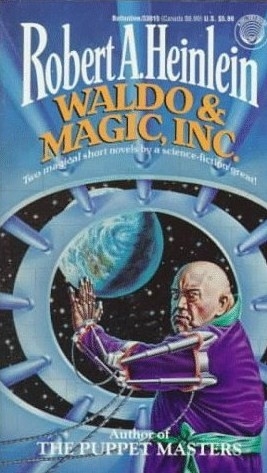
Various extracts from the book:
"Waldo put his arms into the primary pair before him; all three pairs, including the secondary pair before the machine, came to life. Waldo flexed and extended his fingers gently; the two pairs of waldoes in the screen followed in exact, simultaneous parallelism. "
——This invention, also called the Waldo F. Jones Synchronous Reduplicating Pantograph, was immediately put into use in the nascent nuclear power industry.
In the story, Heinlein plays around with the idea. He considers waldoes that are so small, they look like "tiny pixy hands, an inch across." He also describes some very large waldoes: There were waldoes rigged near the spherical wall, too, including a pair so huge that Stevens could not conceive a use for it… Extended, each hand spread quite six feet from little finger to thumb tip.
———-

During World War II, Heinlein did aeronautical engineering for the U.S. Navy, also recruiting Isaac Asimov and L. Sprague de Camp to work at the Philadelphia Naval Shipyard in Pennsylvania.
–
…
"… Neither electromagnetic instruments nor neural surgery was refined enough to do accurate work on the levels he wished to investigate.
But he had waldoes.
The smallest waldoes he had used up to this time were approximately half an inch across their palms–with micro scanners to match, of course. They were much too gross for his purpose. …
He used the waldoes to create tinier ones. …
His final team of waldoes used for nerve and brain surgery varied in succeeding stages from mechanical hands nearly life size down to these fairy digits which could manipulate things much too small for the eye to see. They were mounted in bank to work in the same locus. Waldo controlled them all from the same primaries; he could switch from one size to another without removing his gauntlets. The same change in circuits which brought another size of waldoes under control automatically accomplished the change in sweep of scanning to increase or decrease the magnification so that Waldo always saw before him in his stereo receiver a “life-size” image of his other hands."————-
"Even the ubiquitous and grotesquely humanoid gadgets known universally as 'waldoes'-Walso F. Jones's Synchronous Reduplication Pantograph, Pat. #296,001,437, new series, et al-passed through several generations of development and private use in Waldo's machine shop before he redesigned them for mass production… Near the man, mounted on the usual stand, were a pair of primary waldoes, elbow length and digited. They were floating on the line, in parallel with a similar pair in front of Waldo. the secondary waldoes, whose actions would be controlled by Waldo himself by means of his primaries, were mounted in front of the power tool in the position of the operator…(pp24, 26)
1948 GE Master-Slave Manipulator – John Payne
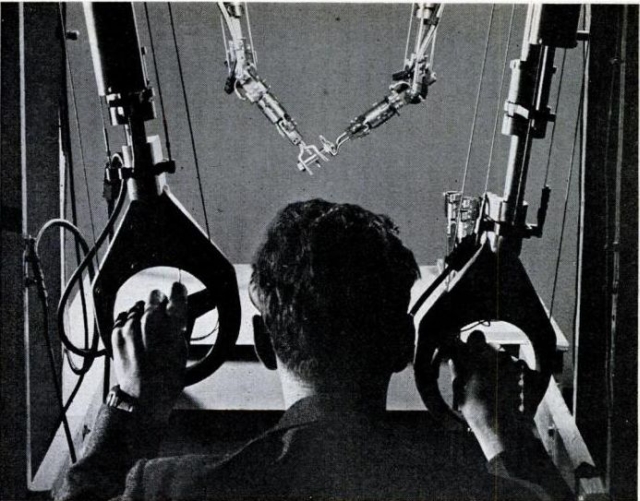
Patent number: 2476249 (see here)
Filing date: Nov 24, 1948
Issue date: Jul 1949
1948 Ray Goertz Master-Slave Manipulator
(Developed in 1948 – patent filed in 1949)

Patent number: 2632574 (see here)
Filing date: Dec 16, 1949
Issue date: Mar 1953
1953 Harvey Chapman – Garco
Garco – Harvey Chapman Jr., 1953.
Patent number: 2858947 (see pdf here)
Filing date: Nov 16, 1953
Issue date: Nov 1958

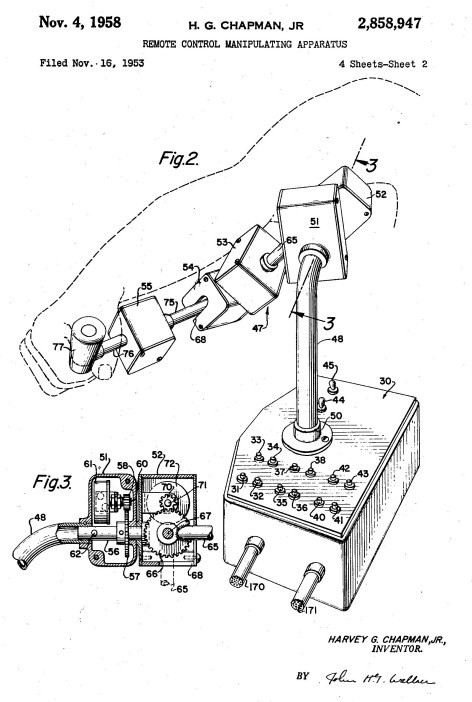
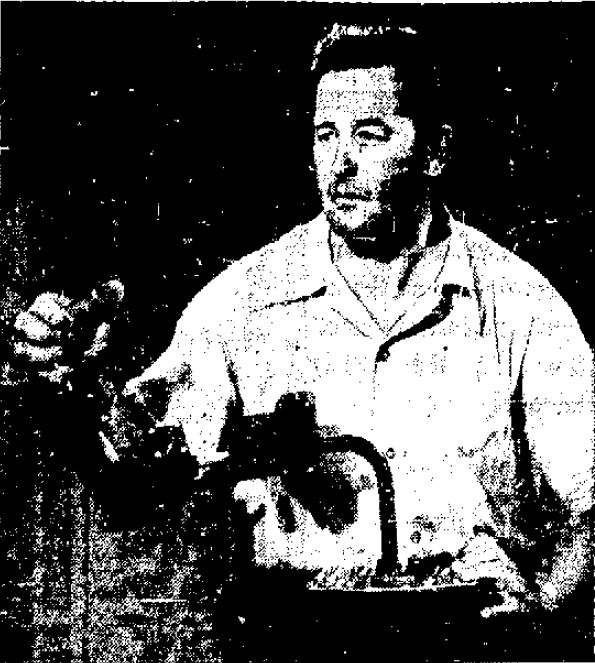

The control arm of the master-slave unit pre-dates the harness used by the Disney Imagineers for their Audio-Animatronics by 10 years. Were they inspired by what they saw back then in MARS AND BEYOND (DISNEY, 1957)?
Mars & Beyond is an episode of Disneyland (The History and Future of Man and Space) which aired on December 4, 1957. It was directed by Ward Kimball & narrated by Paul Frees. This episode discusses the possibility of life on other planets, especially Mars. It begins with an introduction of Walt Disney & his robot friend Garco, who provide a brief overview.
1954 Ray Goertz Servo-Manipulator
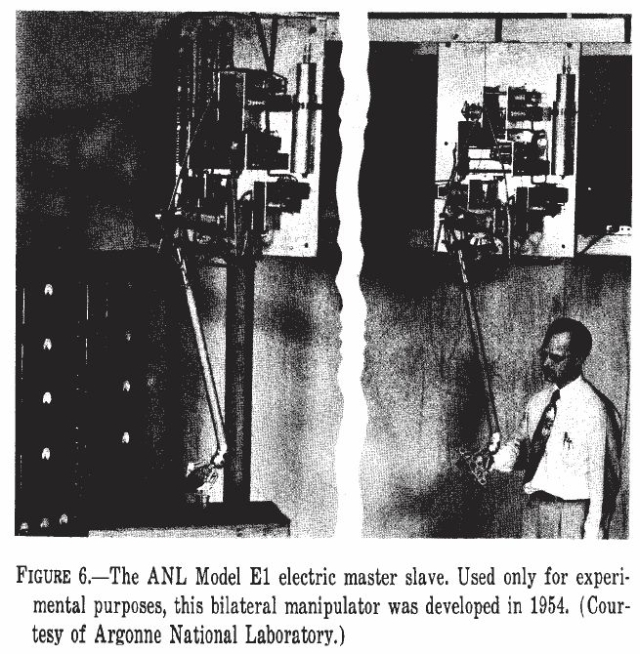
The significance of this model is that the electrical connection rather than a mechanical connection allowed a much larger distance between the master and slave components.
Patent number: 2846084
Filing date: Jun 21, 1955
Issue date: Aug 1958
1956 GE Yes Man
An early, if not the first, master-slave manipulator to employ an Exoskeleton Master. (see post here)
1963 Rogers / Disney – Patent for Animating Apparatus
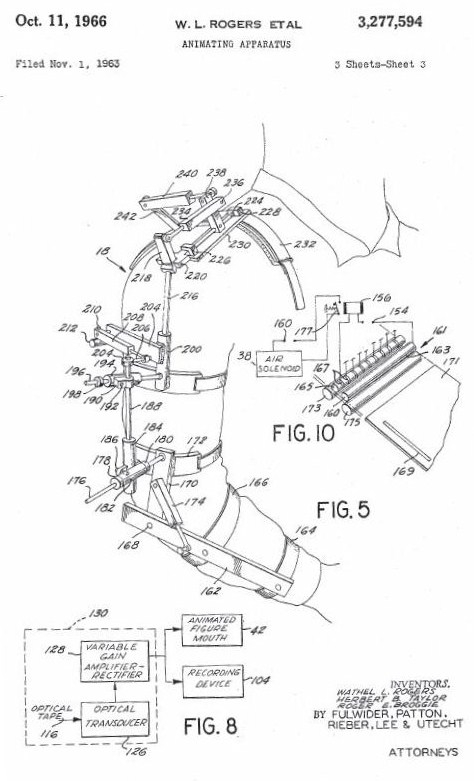
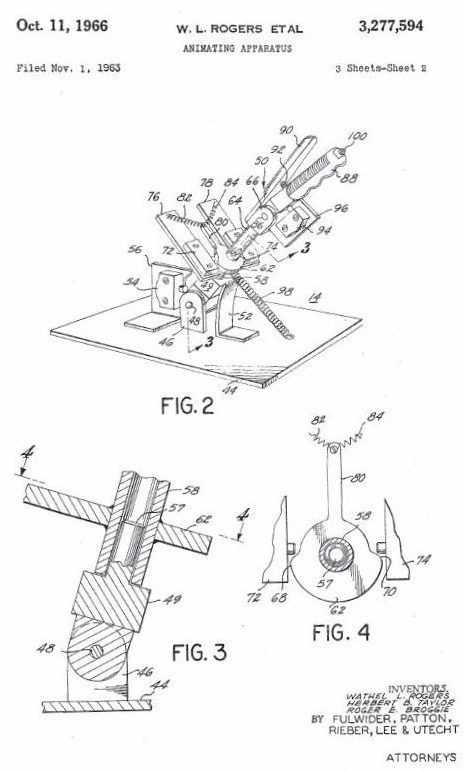
Wathel L. Rogers, Herbert B. Taylor, and Roger E. Broggie.
Patent number: 3277594 – Animating Apparatus (see here)
Filing date: Nov 1, 1963
Issue date: Oct 1966
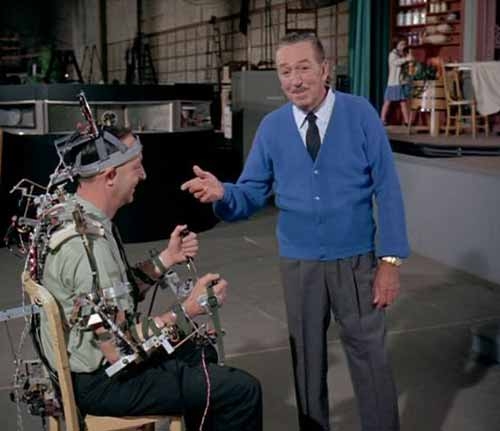
Originally named General Electric Carousel of Progress, the show was personally created by Walt Disney for the 1964-65 New York World's Fair. It played at Disneyland theme park in California from July 2, 1967 until September 9, 1973. The show next moved to Magic Kingdom theme park in Florida where it opened on January 15, 1975. In 1994, the show was rewritten and restaged with the new name Walt Disney's Carousel of Progress.
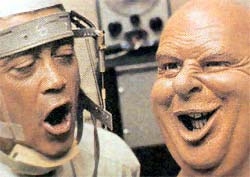
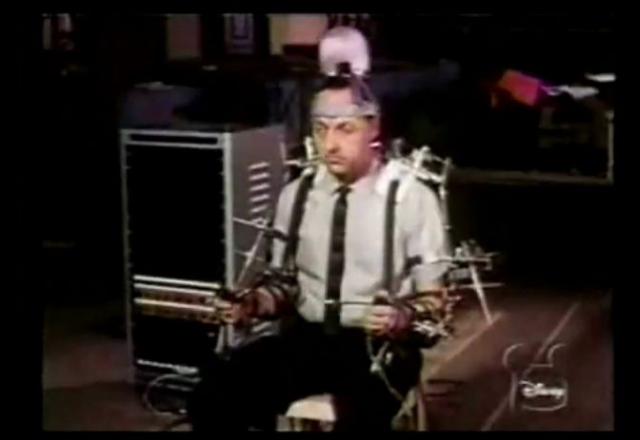
Wathel Rogers operating the "animating apparatus".
1963 Science & Mechanics – "Waldo" as master-slave manipulators
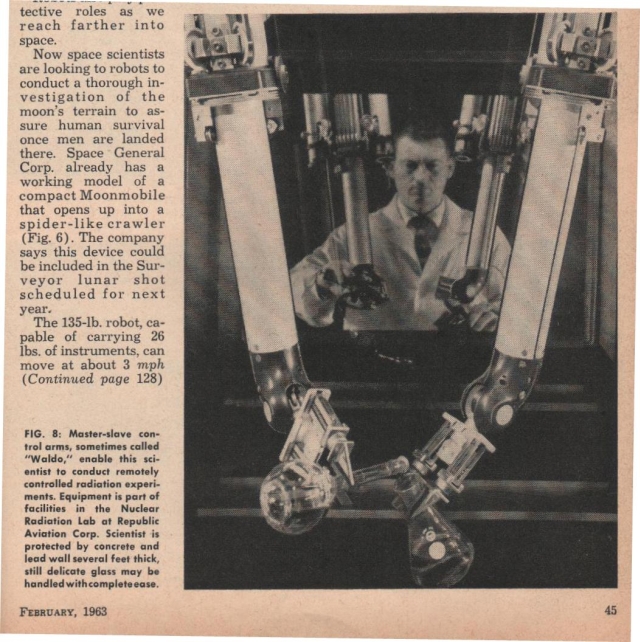
An early reference to "Waldo" as a Master-Slave Manipulator – (Science & Mechanics Feb 1963).
Some more "waldo" book references (from answers)
1957 R. Silverberg One-Way Journey World of Thousand Colors (1984) â„– 131: We make a good team on the waldoes.
1969 A.C. Clarke 2001: A Space Odyssey (1969) Discovery's extravehicular capsules or "space pods" were spheres about nine feet in diameter, and the operator sat behind a bay window which gave him a splendid view. The main rocket drive produced an acceleration of one-fifth of a gravity—just sufficient to hover on the Moon—while small attitude-control nozzles allowed for steering. From an area immediately beneath the bay window sprouted two sets of articulated metal arms or "waldoes," one for heavy duty, the other for delicate manipulation. There was also an extensible turret carrying a variety of power tools, such as screwdrivers, jack-hammers, saws, and drills. Space pods were not the most elegant means of transport devised by man, but they were absolutely essential for construction and maintenance work in vacuum. They were usually christened with feminine names, perhaps in recognition of the fact that their personalities were sometimes slightly unpredictable. Discovery's trio were Anna, Betty, and Clara. Once he had put on his personal pressure suit—his last line of defense—and climbed inside the pod, Poole spent ten minutes carefully checking the controls. He burped the steering jets, flexed the waldoes, reconfirmed oxygen, fuel, power reserve.
1973 J. Tiptree, Jr. Girl Who Was Plugged In Screwtop/Girl Who Was Plugged In (1989) â„– 18: But Delphi is no robot. Call her a waldo if you must. The fact is she's just a girl, a real live girl with her brain in an unusual place.
1978 D.A. Stanwood Memory of Eva Ryker â„– 30: The bathyscaphs are both equipped with remote manipulators — the experts call them "Waldos" — for working under the extreme pressure.
1982 W. Gibson Burning Chrome T. Shippey Oxford Book of SF (1992) â„– 500: I was working late in the loft one night, shaving down a chip, my arm off and the little waldo jacked straight into the stump.
1987 T. Easton Analog SF/Sci. Fact (Sept.) â„– 165/1: In Pohl's case, the aliens are using humans as organic waldoes that permit them to meet and bargain for Earth's wealth, and the humans be damned.
1993 K.S. Robinson Red Mars (1993) â„– 373: We're like dwarves in a waldo […]. One of those really big waldo excavators. We're inside it and supposed to be moving a mountain, and instead of using the waldo capabilities we're leaning out of a window and digging with teaspoons.
1996 D. Pringle, et al. Ultimate Ency. of SF â„– 106/3: The climax comes when Ripley, clad in waldo-ized battle gear, takes on head-to-head the queen of the alien hive in a dazzling set-piece.
1990 – The Character Shop – WaldoTM
The USPTO has given the WALDO trademark serial number of 74090309. The current federal status of this trademark filing is REGISTERED AND RENEWED.
Filing Date: 8/22/1990
The WALDO trademark is filed in the category of Computer & Software Products & Electrical & Scientific Products . The description provided to the USPTO for WALDO is special effects equipment in the nature of an ergonomic telerobotic control device.
Waldo was a generic, commonly used term for puppet and animatronic control devices that was used by a variety of different companies and organizations including the Muppets until it was appropriated and registered as a trademark by the Character Shop, a California-based creature effects company. Because of this, while the use of waldo-like devices is widespread in puppetry and visual effects, The Character Shop is the only company in the United States permitted to use the name "Waldo" commercially for puppet control devices.
From http://www.character-shop.com/waldo.html –
The term was first used in a Robert Heinlein short story, which was about a disabled scientist named Waldo who managed to build devices that would amplify his strength. These "waldoes" went on to replicate bigger machines, and so on. At least that's the way I remember it happened. NASA scientists nicknamed some of their early telemetry systems "waldo", and when the rare telemetry device popped up, sometimes that caught the nickname.
"When we started pioneering the use of telemetric input devices for puppetry, we researched the name "Waldo" with the trademark registry. It had never been officially appropriated; no one had ever gone to market with telemetry devices, called them waldoes, and trademarked it. So, The Character Shop applied for and received the trademark for its line of input devices. Now, we've been accused of ripping Mr. Heinlein off; that's far from the case. We obtained the trademark with utter respect, and in an homage to Mr. Heinlein. Mr. Heinlein wrote a work of fiction, and a character in the story was named Waldo. One cannot copyright the name of a fictional character in literature, unless, perhaps it originates with the author. Mr. Heinlein was not intending to market telemetry devices, he was writing a science fiction story. So there was no need or reason for him to trademark the name. Just as Asimov popularized the term "robot", Mr. Heinlein has an inspirational claim to the term."
Comment: RH Dec 2010 – regarding Trade Marking the word "Waldo", I feel that The Creature Shop have undergone some criticism over doing so. My initial reaction was similarly negative. However, the bigger concern is that a coined word in public use was able to be Trade Marked in the first place. Given that situation, it is more fitting that a company such as The Creature Shop has it, over another that may not be as appropriate or fitting at all.
My personal feeling is that , like some patents, one should get the credit for whatever it is, then put it in the public domain. I don't know how you would do that for Trade Marks. I know in the .com era things went crazy over common words, symbols, etc that could be and were Trade Marked. Sometimes common sense doesn't prevail.
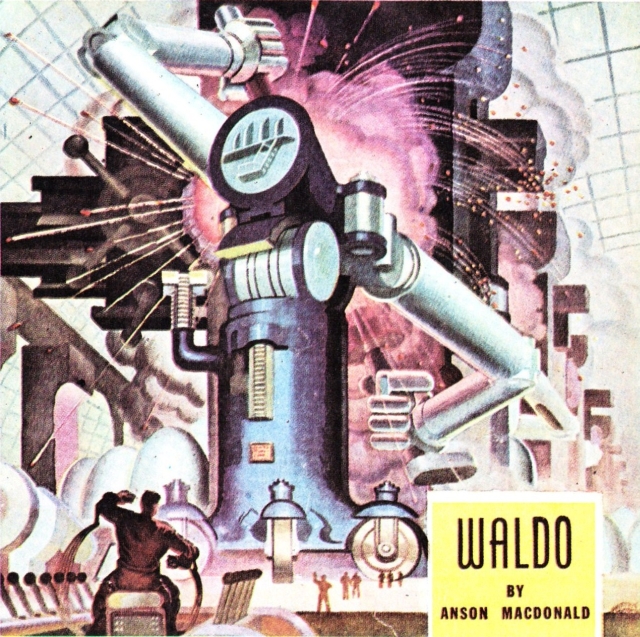
Cover by Hubert Rogers.

"Amazing Stories" September 1952 cover by Walter Robert Popp showing Mechanical Master-Slave Manipulators.. Story by Paul W. Fairman.